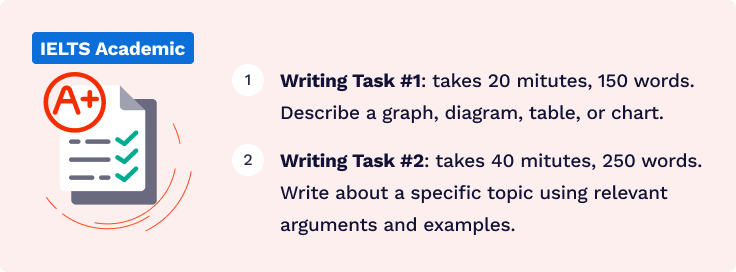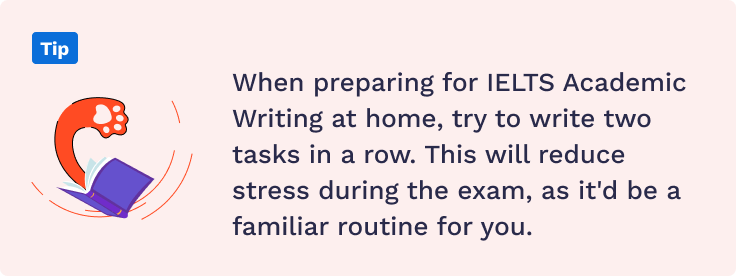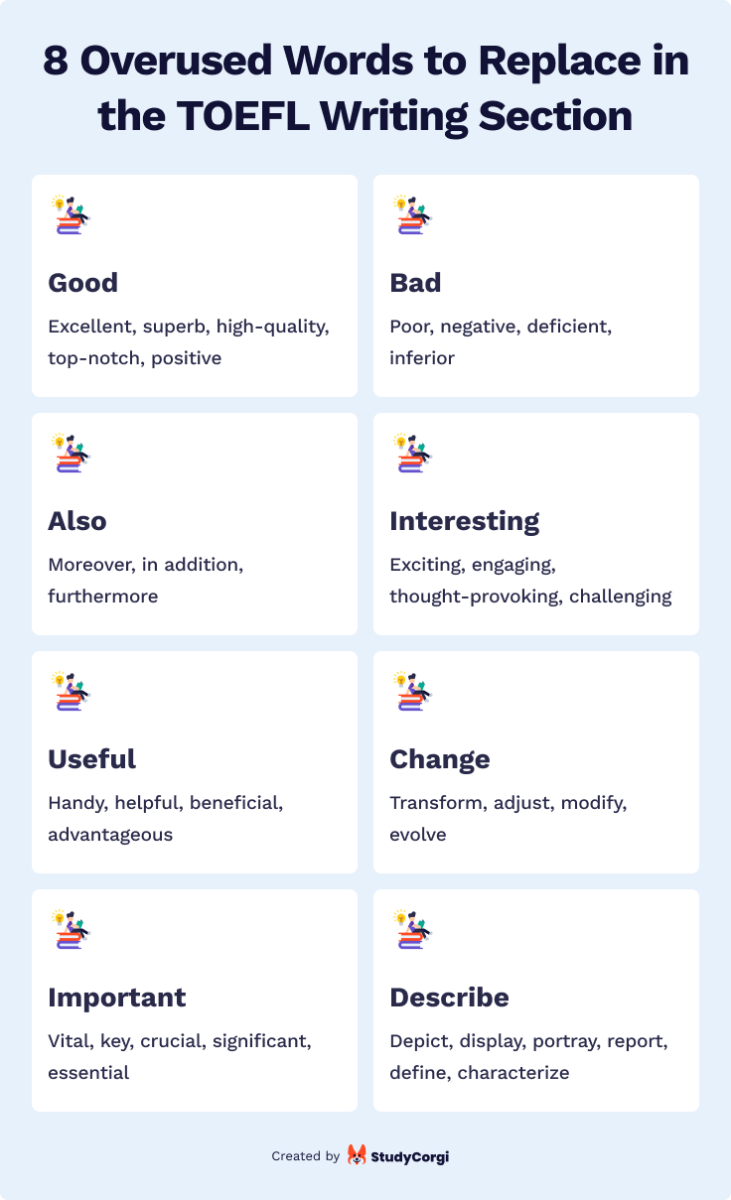Are you having a tough time preparing for the writing part of the IELTS exam? This test may be a great challenge as it requires non-native English speakers to show a high level of language skills. Although the questions differ from year to year, the IELTS academic writing task structure remains the same, so you can quickly get the gist of what to expect.

We prepared an ultimate guide to the exam’s written assignments, presenting the most actionable IELTS tips and tricks for you to achieve the highest results. In our article, you will find instructions on: analyzing the task, outlining your composition, and avoiding common errors. After you’re done reading, head over to our database and check out some free essay samples to get familiar with the format. Let’s make the first step to your 9.0 in the IELTS writing part!
📋 How to Prepare for IELTS at Home
IELTS is one of the common exams for non-native English speakers who want to apply to a university or a long-term visa. Some people admit that it’s hard to prepare for it without a tutor or language courses. We won’t say that it’s wrong, but here is why you should try studying for it on your own:
- You can develop your approach and follow the best IELTS writing practice designed particularly for you.
- You can access diverse resources instead of being limited to a few books.
- There are many free online services and platforms to strengthen your IELTS advantageous writing skills and learn more about the IELTS exam.
Now, let’s take a glance at the test’s key milestones.
Basically, IELTS can be of two types: Academic or General. Because most of our audience is students, it’s more reasonable to start by mentioning the first one and because it is the harder one. Regardless of the exam’s type, it consists of four blocks: Reading, Listening, Writing, and Speaking so that the inspectors can give your skills a comprehensive assessment.
The Listening section contains four tasks of 10 questions each and is the same for both General and Academic types. Speaking doesn’t differ in both exams and includes various types of questions that you will be asked during a short 10-14-minute interview. They cover such topics as your hobbies, attitude to current events, general preferences, etc. Also, the examiner will ask you to discuss some specific issues.
Both Reading and Writing sections are unique in General and Academic IELTS. For the latter, they are a bit more challenging and science-oriented than the former. The Academic exam test-takers will have to deal with longer yet fewer passages on various subjects from astronomy to biology. You will have the time limit of one hour to answer 40 questions for the Reading section. Finally, the Writing part’s timing is the same, and the difference between IELTS General Writing and Academic is in the complexity of the IELTS essay topics you should discuss.
If you want to succeed in the exam, you need to know what a good IELTS score is and what band do you need. Usually, universities require IELTS Band 7+, and you need Band 8+ to find a job.
Now, it’s time to learn about the Writing Task 1 and 2 in IELTS in more detail.
✏️ IELTS Exam Structure: Writing Tasks Overview
First, let’s see the basic features, time limits, and word count requirements of the IELTS Academic Writing tasks. They are specific for this type of exam, and you should stick to them if you want to score a high mark.
Some general IELTS Writing tips that the instructor will also repeat to you before you start doing this section are:
- Don’t open the task before you’re told to.
- Make sure you leave enough time on copying the answers to the answer booklet.
- Task 2 is twice as valuable as Task 1 in this section, so be sure you do both.
The information above refers to the Academic IELTS training; now, let’s see what IELTS writing tips for General training are. It’s much less complex than the previous one and focuses on your ability to discuss everyday issues. The IELTS general writing tips are also similar to the ones for the Academic section. In the table below, you can see the key information about this section.
🔎 IELTS Academic Writing Task 1: What to Expect
You already know the basics, so we will show you what you can expect from the writing section’s first task. You should be prepared for some obstructions, but we also developed a prompt plan of smashing this part.
So, what are the challenges of IELTS Writing Task 1?
Firstly, you should be able to analyze data and detect which subject it relates to quickly. It might be obvious, but there are also cases when it turns into a guessing game or when you are not familiar with the topic. However, this doesn’t mean you will fail the task because it requires more basic logic than any specific knowledge.
Tip: If you’re concerned about the subject of the diagram, imagine that it is about something you are familiar with.
Remember that you shouldn’t describe anything at a professional level. And there’s excellent news – in many cases, you will already have most of the needed words written in the picture. All you need to do is analyze it and structure the answer. However, this doesn’t mean you don’t need to learn IELTS writing task 1 vocabulary.
Although you’re not asked to write an essay in this task, your writing piece should follow a basic outline that includes an introduction and main body. There can be a conclusion, too, depending on your question. You can check out IELTS Writing Task 1 sample and templates to understand what it is about better.
This assignment is relatively predictable in terms of the image you will have to discuss. That’s why the best practice to prepare for it is to write descriptions of each type of graphics: a pie chart, bar chart, graph, diagram, and a process scheme. This activity will help you see the slight differences in writing about each type of data visualization. For instance, when writing about a process, you will have a specific chronology. Describing pie charts and graphs may involve predicting future changes in the presented statistics.
Finally, we’ve made a short timing instruction for you to fit in the limitations with zero hassle. Here it is:
📌 IELTS Academic Writing Task 2: Tips
The second task is IELTS essay writing, and it is a bit more complex than the first one. One of the challenges is that by the time you start doing it, you may be already stressed out by the previous assignment and unable to fulfill it properly. However, there’s a trick that will help you out.

Another deal is that this assignment requires an understanding of the IELTS Writing Task 2 structure basics. Not only should you care about the content but also about the outline of your composition. Usually, the task includes a statement and two questions. This is a typical flow that you can get used to quickly so that each time you come to this task, you will know how to compose it.
Ideas for IELTS Topics
Same as with Task 1, you may encounter difficulties here because you are not familiar enough with the topic. Remember that Academic IELTS is a more specific test, requiring understanding such subjects as production, business, science, technology, etc. However, you shouldn’t be too anxious about this. The topics will certainly differ each year, but you may come across similar ones in each field of study. Here is a list of ideas for IELTS topics that might be helpful to explore to prepare for this task: ads, art, business, charity, clothing, communication, construction, ecosystem, education, employment, freedom, gender, globalization, health, history, law, leadership, media, money, population, psychology, salary, science, society, success, technology, traditions.
It will be beneficial to analyze popular issues related to each of the areas mentioned above. Then, you will be 100% ready to encounter any topic on the exam and not feel like you lack knowledge or experience in it. Another useful activity is to check out IELTS essay topics with answers in popular practice books.
IELTS Writing Task 2: Structure
Generally, the questions that you may come across at the exam Writing Task 2 can be grouped as follows:
- Agree / Disagree
- Discussion
- Cause & Solution
- Direct Question
Now, let us remind you some basics of the IELTS essay structure to apply to this task. An average writing piece consists of an introduction, main body, and conclusion. In the introduction, you should present the context your issue relates to and a thesis statement representing your text’s main idea. In conclusion, you should restate the thesis statement, supporting it with new details that you’ve mentioned in the main body. The central part of your composition will speak of different facts and arguments supporting or opposing the thesis statement.
You may be wondering how to make the most use of the topic and questions in your Writing Task 2? Here are our thoughts.
You can paraphrase the first sentence in bold that you will see on your exam booklet into a powerful thesis statement. You can use synonyms and change the word order so that you have a unique, compelling sentence. For instance, you have a topic that sounds like this:
Today, the air is polluted, especially in big cities, which increases the risk of lung cancer among residents.
Let’s paraphrase it into a unique thesis statement, replacing the words with their synonyms:
In the recent years, air contamination in metropolises has become one of the factors impacting on the likelihood of getting lung cancer.
And what about the questions you have in the task? You can use those for the main body section. Answer them in separate paragraphs, and that’s it! The conclusion is also easy to formulate if you managed to write an introduction.
IELTS Writing Task 2: Common Mistakes to Avoid
In this section, you will learn what are the usual grammar and content mistakes in the IELTS essay writing. First of all, let’s speak of the general issues that may reduce your total score points.
- Focusing only on the questions or only on the statement in the task.
As a golden rule, you should remember that every word in the exam task is equally valuable, and you can make use of it. Not only will you lose points if you miss anything, but it will be much harder and time-consuming to come up with an excellent writing piece. - Writing about something unrelated to the topic.
When fulfilling this assignment, you may be taken away by inspiration and write too much useless information. To avoid this, highlight the main keywords in the assignment and structure your answer considering them. - Ignoring composition structure standards.
As we mentioned in the previous block, the outline is one of the major aspects of your answer. You will lose almost half of the points if your composition doesn’t follow the structure basics. - Not supporting your arguments with real facts.
One of your aims is to present your perspective and make it sound compelling enough in the second task. Support your words with data or examples from your personal experience to achieve this. - Writing too many overused words.
The last common mistake among all IELTS participants is using clichéd words. Below you can find a table with popular overused words and their more advanced synonyms that you can use in your answer.

Now, it’s time to review some common grammar mistakes. First of all, it’s crucial for you to proofread your writing piece. You can either stop after finishing up a paragraph and do a quick quality check or do that when you complete the entire assignment. Here’s a list of the five most frequent errors that inspectors see in exam-takers answers:
- Correct use of articles
- Use of the commas,
- Verb and noun agreement,
- Confusing Past Simple and Present Perfect,
- Using improper prepositions after nouns and adjectives.
The best practice to avoid these mistakes is to consult official websites such as Cambridge Dictionary.
💡 IELTS: General Writing Tips
By now, we have covered almost all specific tips and tricks for the Writing section of the IELTS exam. However, there are some more universal recommendations on boosting your performance that we would like to share with you.
In this article, we reviewed the structure of both tasks and their specific features. Task 1 aims at detecting your skills of describing visual data, while Task 2 asks you to express your opinion on a particular issue. You also received a guide through some popular topics and types of questions in Task 2.
One of the reasons why people fail the Writing section is making too many small mistakes. Also, you can get a lower score because you are too creative about the task. The best practice is to stick to a specific writing routine and properly plan your answers. Then, it will be much easier and less time-consuming to fulfill the tasks.
We hope that our tips will help you boost your writing skills and prepare for the Academic IELTS test. Keep up with our updates to learn more about language competency exams!
